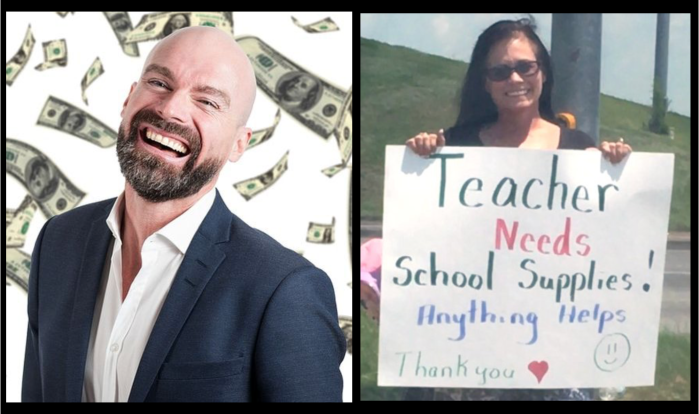
Ever wonder why our roads and public school buildings are crumbling?
Ever wonder why schools can’t afford books, buses and nurses?
Ever wonder why classroom teachers are forced to buy paper, pencils and supplies for their students out of pocket?
Because businesses like Giant Eagle, American Eagle Outfitters, and Eat’n Park aren’t paying their fair share.
It’s a simple concept – you belong to a society, you should help pay for the roads, bridges, schools, etc. that everyone needs to keep that society healthy.
After all, as a stockholder, CEO or business owner, you directly benefit from that society. If it didn’t exist, you wouldn’t have nearly as many customers – if any.
Many of us learned this kind of stuff in kindergarten or grade school.
But ironically programs that allow businesses to avoid paying their fair share are being used to short change many of those same kindergarten and grade schools.
In Pennsylvania, one such program is called the Educational Improvement Tax Credit (EITC), and everyone from local banks to Duquesne Light to UPMC healthcare providers are using it to lower their taxes while stealing from the public school cookie jar.
Here’s how it works.
If you expect a tax bill of $X at the end of the year, you can donate that same amount to the state for the purpose of helping parents pay off enrollment at a private or religious school for their children. Then you get between 75-90% of that donation back.
So if your tax bill is $100 and you donate $100, you can get back $90 – reducing your total tax bill to a mere 10 bucks.
Heck! Since this money is classified as a “donation” you can even claim it on your taxes and get an additional refund – even to the point where you end up making money on the deal! Pennsylvania even allows a “triple dip” – so you get the EITC tax credit, a reduction in your taxable income, and a reduction in your federal taxable income. We actually pay you to shortchange us on your taxes!
Now I’m oversimplifying a bit since you can only use the EITC for up to $750,000 a year, but it’s still a sweet deal for businesses. It just really hurts nearly everyone else because it reduces the state’s general fund – by $124 million last year, alone.
When we give away hundreds of millions of dollars every year to religious and parochial schools, we have less money to spend on public schools, roads and all other services that benefit the majority of our citizens – especially the poor who rely more heavily on these services.
So why doesn’t the state just budget this amount of money directly to religious and private schools instead of ransacking the general fund after businesses donate it to the tax incentive program?
Because it’s illegal to give taxpayer dollars to religious and private schools. The establishment clause of the First Amendment forbids it.
The founders of our country didn’t want a state religion with schools teaching theological propaganda like we had in Great Britain. Moreover, they demanded tax dollars be spent with accountability to the whole public – something you cannot do in a private or religious school which isn’t set up for everyone but only those who choose and can afford to go there.
However, some smart ass thought of an alleged loophole. He said that if tax money is turned into a tax credit, it’s no longer tax money and it doesn’t violate the rules to spend it on religious and private schools.
So this is a fiscal sleight of hand meant to give businesses a tax break while boosting private schools.
Who’s guilty of hiding behind this loophole to bolster their bottom line while short changing ours?
Probably a lot of businesses you know.
Thankfully, their donations to the EITC Program are a matter of public record as is how much money returned to them as savings.
You can find a handy database of state businesses right HERE searchable by county compiled by Pennsylvania Capital-Star.
I happen to live in Allegheny County in the Pittsburgh region – the second highest area of the Commonwealth for these tax dodge…. I mean credits.
Across the county in 2017-18 (the most recent year for which data is available), Allegheny County businesses donated $15,741,544. They got back $14,180,261 in tax credits.
A quick search came up with these noteworthy businesses:
–Fatheads – the Southside sports bar along Carson Street in Pittsburgh
Contribution: $ 10,000
Tax Credit: $ 9,000
–AEO Management, Co. (American Eagle Outfitters Corporate Office in the South Side, Pittsburgh)
Contribution: $ 350,000
Tax Credit: $ 315,000
–Apex Diamonds, Inc. (A Pittsburgh jeweler)
Contribution: $ 149,000
Tax Credit: $ 134,100
–Cochran Motors, Inc. (car dealership in Monroeville)
Donation: $ 100,000
Tax Credit: $ 90,000
–Deer Leasing Co. (freight and cargo business) THREE ENTRIES:
Donation: $ 444,444
Tax Credit: $ 400,000
Deer Leasing Co.
Donation: $ 221,111
Tax Credit: $ 200,000
Deer Leasing Co.
Donation: $ 388,888
Tax Credit: $ 349,999
-Dollar Bank – TWO ENTRIES
Donation: $ 225,000
Tax Credit: $ 202,500
Dollar Bank
Donation: $ 400,000
Tax Credit: $ 360,000
–Duquesne Light Company – THREE ENTRIES
Donation: $ 10,000
Tax Credit $ 10,000
(So 100% return on investment!?)
Duquesne Light Company
Donation: $ 50,000
Tax Credit: $ 45,000
Duquesne Light Company
Donation: $ 240,000
Tax Credit: $ 216,000
-Eat’n Park Hospitality Group, Inc. (Corporate headquarters in Homestead)
Donation: $ 25,000
Tax Credit: $ 23,500
-Federated Advisory Services Company (Asset management company) – THREE ENTRIES
Donation: $ 111,111
Tax Credit: $ 100,000
Federated Investment Counseling
Donation: $ 111,111
Tax Credit: $ 100,000
Federated Investment Counseling
Donation: $ 222,222
Tax Credit: $ 200,000
–Giant Eagle, Inc. – TWO ENTRIES
Donation: $ 833,333
Tax Credit: $ 750,000
Giant Eagle, Inc.
Donation: $ 221,111
Tax Credit: $ 200,000
–Glimcher Brokerage, Inc. (Real estate company) – TWO ENTRIES
Donation: $ 380,000
Tax Credit: $ 342,000
Glimcher Group, Inc.
Donation: $ 300,000
Tax Credit: $ 270,000
–HM Health Insurance Company (Camp Hill, Pa) – THREE ENTRIES
Donation: $ 50,000
Tax Credit: $ 45,000
HM Health Insurance Company
Donation: $ 243,333
Tax Credit: $ 219,000
HM Health Insurance Company
Donation: $ 165,556
Tax Credit: $ 150,000
–PNC Bank, N.A. – TWO ENTRIES
Donation: $ 685,000
Tax Credit: $ 616,500
PNC Bank, N.A.
Donation: $ 148,303
Tax Credit: $ 133,500
–Rohrich Imports, Inc. (Luxury Pittsburgh Car Dealership)
Donation: $ 60,000
Tax Credit: $ 54,000
–The Buncher Company (property management company) – THREE ENTRIES
Donation: $ 416,667
Tax Credit: $ 375,000
The Buncher Company
Donation: $ 416,667
Tax Credit: $ 375,000
The Buncher Company
Donation: $ 221,111
Tax Credit: $ 200,000
–The Huntington National Bank –TWO ENTRIES
Donation: $ 549,556
Tax Credit: $ 494,600
The Huntington National Bank
Donation: $ 111,111
Tax Credit: $ 100,000
–UnitedHealthcare of Pennsylvania, Inc.
Donation: $ 200,000
Tax Credit: $ 180,000
-UPMC Diversified Services, Inc. (Healthcare provider) – SIX ENTRIES
Donation: $ 200,000
Tax Credit: $ 180,000
UPMC Diversified Services, Inc.
Donation: $ 200,000
Tax Credit: $ 181,000
UPMC Diversified Services, Inc.
Donation: $ 190,000
Tax Credit: $ 171,000
UPMC Health Benefits, Inc.
Donation: $ 200,000
Tax Credit: $ 180,000
UPMC Health Benefits, Inc.
Donation: $ 200,000
Tax Credit: $ 181,000
UPMC Health Benefits, Inc.
Donation: $ 200,000
Tax Credit: $ 180,000
But this leaves out the largest and shadiest group donating to the EITC Program – Limited Liability Corporations (LLCs).
These “special purpose entities” are set up to represent individual donors so they can more easily divert tax dollars to private and parochial schools.
LLCs represent hundreds of individuals who allow the LLC to donate on their behalf and then they get the tax credits passed back to them. It’s a way to encourage the wealthy to get the tax cut and support school privatization without all the hassle of doing the paperwork themselves.
And most (if not all) of these LLCs are set up by religious organizations to boost their own parochial schools.
For instance, Business Leadership Organized for Catholic Schools is perhaps the largest LLC receiving EITC funds.
Across the state, these organization made $15.6 million in donations and claimed $14 million in tax credits.
In Allegheny County, the largest are CASTA-SOS LLC and Pittsburgh Jewish Scholarship LLC.
CASTA was set up by the Catholic Diocese of Pittsburgh. Pittsburgh Jewish Scholarship benefits Jewish schools in the city.
Here’s how much they took from the state general fund last year:
–CASTA-SOS I LLC
Donation: $ 509,500
Tax Credit: $ 458,550
CASTA-SOS II LLC
Donation: $ 460,890
Tax Credit: $ 414,801
–Pittsburgh Jewish Scholarship I LLC
Donation: $ 675,250
Tax Credit: $ 607,725
Pittsburgh Jewish Scholarship II LLC
Donation: $ 750,000
Tax Credit: $ 675,000
EITC money went to almost 1,170 different organizations across the state. A fraction were YMCA’s, the Salvation Army and preschools. But the vast majority were private and religious schools.
Defenders of the project claim this money goes to fund “scholarships” for poor children to help defray the costs of enrollment at these schools.
However, a family making as much as $100,608 per year can qualify for an EITC scholarship for their child. A family with two children could make up to $116,216 and still qualify.
Consider this: one of the largest single recipients of this money in Allegheny County was the exclusive Shady Side Academy in Pittsburgh. The private secular school took in almost $1 million last year so that its wealthy students didn’t have to spend as much on enrollment.
Why are we subsidizing the rich?
Why are we robbing the poor to do so?
Why are we using public money to fund the teaching of climate denial, creationism, indoctrination in religious and political ideologies?
The short answer – our politicians are spineless and indebted to the people this benefits.
Just this summer, the Pennsylvania legislature AGAIN increased the limit for the program by an additional $25 million.
That’s the pattern. Every year, the Republican-controlled (and heavily gerrymandered) legislature can’t get their regressive policies passed Democratic Gov. Tom Wolf. They need some Democrats to support their spending priorities. So they entice right-leaning Democrats with increases to these tax incentive programs in order to reach compromises.
But it could have been worse. Earlier in the year, the legislature passed a measure to increase the EITC Program by $100 million. Thankfully it was vetoed by Gov. Wolf. Unfortunately, he let the $25 million increase get through.
This is a problem that is not going away.
We need to let our lawmakers know in no uncertain terms that we do NOT support these programs. And this isn’t just Republican lawmakers. We especially need to pressure Democrats and even run challengers to those who are not progressive enough in the primaries.
And we need to let businesses who partake of the smorgasbord of tax credits that doing so will lose them our business.
If we want to stop theft disguised as “tax credits,” we have to start hitting these businesses where it hurts – in the pocketbook.
Because they certainly don’t feel it in their hearts.
Like this post? I’ve written a book, “Gadfly on the Wall: A Public School Teacher Speaks Out on Racism and Reform,” now available from Garn Press. Ten percent of the proceeds go to the Badass Teachers Association. Check it out!





